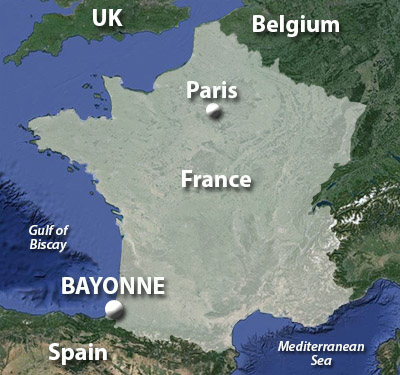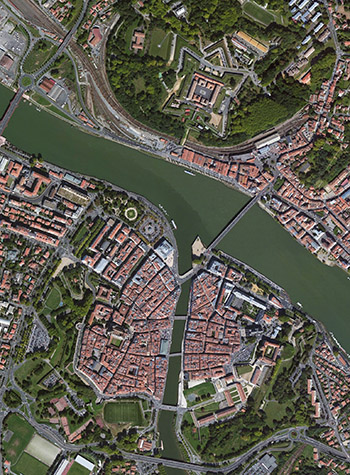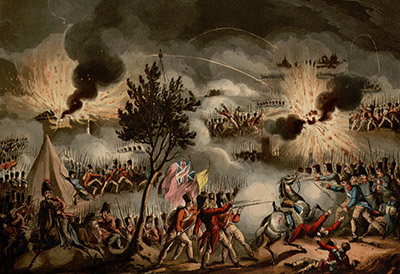 |
Citadelle Bayonne
Bayonne, France
|
|
 |
Constructed: 1680-1685
Designed by: Vauban
Used by: France
Conflicts in which it participated:
Peninsular War
|
The fortified city of Bayonne, from whence came the bayonet*, was one of many French communities that benefited from the genius that was Vauban.
Due to the convergence of the Adour and Nive Rivers, the location that would become Bayonne is, at least according to Wikipedia, which we all know is 100% accurate in all things, "the oldest documented human occupation site." Perhaps, but the Romans could certainly be depended upon to identify a strategic location, and by the 1st century AD they had already built a wall around a settlement there. |
 |
 |
|
Fortified to keep out unruly tribes of local hooligans, this region, named Novumpopulania by the Romans, was important because it permitted the monitoring of the main route one might take if interested in crossing the Pyrenees Mountains betwixt modern France and Spain. A Roman Castrum was in existence at Bayonne when the Romans left the region at the end of the 4th century AD. Some of those Roman walls are still part of Bayonne's defenses today, as it has remained a fortified city ever since!
|
 The fortified city of Bayonne and its spectacular Citadel. |
 |
A castle named Floripes ("flowery foot") was built at the northwest corner of Bayonne's walls in the 12th century, during a period of rapid expansion and fortification of the town. Separated by the Nive River, Bayonne developed as two distinct fortified townlets: Petit Bayonne to the east of the river, and Grand Bayonne to the west.
The Italian War of 1521-1526 (in which France allied with the Republic of Venice against the Holy Roman Empire, England and the Papal States over the election of Charles V (1500-1558) as Holy Roman Emperor) brought the besiegin' Spanish army to Bayonne in 1523. Bayonne's walls proved sufficient to the job, keeping the Spanish at bay until the fortuitous intervention of a French army headed by Odet of Foix, Viscount of Lautrec (1485-1528) broke the siege later that year.
Bayonne had prepared for just such a siege by demolishing the slums that lay outside the city's walls, reasoning that they would be easily occupied by attackers, affording them shelter. Whether or not the hipster Spanish were disappointed that there were no cool slums in which to hang out upon their arrival at Bayonne went unrecorded.
|
|
|
For the next 150 years, a series of French king's engineers left their mark on Bayonne's fortifications. The result was a series of irregular, unmatching bastions sticking out in a semimenacing fashion from the town's walls: Grand Bayonne wound up with five bastions and two gates, while Petit Bayonne made do with four bastions and one gate.
|
Everything changed around 1670, when Sébastien Le Prestre de Vauban showed up. Vauban, whom for those of us who have not been paying attention is known as the "Father of the Starfort," was sent to Bayonne by France's Sun King, Louis XIV (1638-1715), to work his Vaubannian magic to secure the border at this southwestern extremity of France, as he had done at Perpignan, at France's south eastern extremity. Vauban added some demilunes to Bayonne's existing fortifications, but more importantly to we of the starfortish persuasion, he designed and oversaw the construction of the Citadelle.
|
 |
 Citadelle Bayonne, watching over its city. Citadelle Bayonne, watching over its city. |
|
Bayonne's 12th century castle, Floripes, was dismantled during this period. Vauban obviously had a healthy disdain for such edifices as castles in the modern age of the 1670's.
Lots of things also changed when Napoleon (1769-1821) became Emperor of France in 1804, though little in the way of starfort construction. In 1808 representatives of France and Spain met in Bayonne and hammered out the Bayonne Statute. This agreement was essentially Spain saying, "sure, we'd love to be ruled by Napoleon's older brother, Joseph Bonaparte (1768-1844), and thanks for this constitution promising us sovereignty, which you will completely ignore when it suits you!" And so it was.
A mere five years later, an Anglo/Portuguese/Spanish army led by Sir Arthur Wellesley, 1st Duke of Wellington (1769-1852), defeated Marshal Soult (1769-1851) at the Battle of the Nive (December 9-13, 1813). Foul weather prevented any active campaigning directly thereafter, but by the end of February, 1814 Wellington had crossed the Adour River, isolating Bayonne.
|

The catchily-titled The Sortie from Bayonne, at 3 in the Morning, on the 14th April 1814 by Thomas Sutherland. |
 |
A siege ensued, but it was a siege that was "leisurely to the point of apathy." It was clear that Napoleon's reign was nearly at an end, and the war was all but over. British and French troops fraternized, exchanging letters and whatever goods they had to exchange.
On April 12, the news of Napoleon's abdication reached the French garrison at Bayonne. Though this meant that the war was effectively over, the French commander, General Pierre Thouvenot (1757-1817), ordered 6,000 (of his garrison of 10,000) men to sortie from the city at 3am on April 14, "in a fit of spite and frustration." The Battle of Bayonne was on, baby.
|
|
|
A brief aside about the sortie. Virtually all starforts were equipped with a sally port, which is a strategically-placed portal, separate from the main gate, through which a force might "sally forth" and attack its besiegers. The thought of a besieged fort's garrison bursting out of a sally port and successfully attacking those surrounding that fort has always seemed an extremely unlikely exploit to me. A fort has a known number of openings from whence a sortie might proceed, and if a body of soldiers is besieging a fort, one would think that they would be particularly attentive to those openings, thus precluding the possibility of being surprised by such an adventure. "They attacked us from one of the three portals through which they could have possibly attacked us! Who could've predicted that?!?"
However, there have absolutely been examples of this very thing occurring, including the sortie with which we are presently concerned. Historically, sieges could last for months, even years. A level of complacency on the part of those doing the besieging was inevitable, after long months of no activity other than lots of guys dying from the many diseases from which one could choose in such situations. If a fort's commander was clever enough to time a sortie correctly, perhaps with a distraction elsewhere, at the very least such an attack might lead to the sapping of both the besieger's men and will.
|
Which would ultimately not prove to be the case for the Sortie of Bayonne. Though Thouvenot's surprise attack caused 838 Allied casualties, the French suffered 905. Captured in this battle was the British commander, Lieutenant-General John Hope (1765-1823), which served him right for conducting such a sorry-assed siege in the first place.
Bayonne continued to hold out until April 27, 1814, when Thouvenot received written orders to surrender from Marshal Soult. The Battle of Bayonne was the last major action of the Peninsular War (1807-1814).
|
 |
 A contemporary map including Vauban's additions to Bayonne's defenses. Thanks, Fortified-places.com! A contemporary map including Vauban's additions to Bayonne's defenses. Thanks, Fortified-places.com! |
|
Work continued on Bayonne's defenses until 1846, when the Citadelle's northern ravelin was finally completed. All of Bayonne's defenses except the Citadelle were demilitarized in 1900. The Nazis occupied Bayonne from June of 1940 until August of 1944, randomly gunning down three people as they departed.
Much of Bayonne's city walls remain today, and are reportedly in good condition. The Citadelle is still occupied in some capacity by the French military, and is thus closed to visitors.
*Though unrelated to the sacred art of starfortery, the modern bayonet has its origin in Bayonne. Early muskets were inaccurate and reloaded in a cumbersome fashion, and it became common for a kind of spear to be dropped down a musket's barrel after firing a shot, so that one could defend oneself with something long and pointy. As the story goes, the musket-wielders of Bayonne at the end of the 16th century, notoriously short on powder and shot, found themselves more often than not holding their muskets with the spear sticking out. Determined to improve upon this clumsy contrivance, Bayonners devised a blade that was affixed alongside or beneath a musket's barrel, leaving it free to be reloaded if possible, or to be used as a stabbing device if not. The bayonet was commonly issued in all European armies by the 1660's. Thanks, Bayonne!
|
|
|
|
|
|
 |




